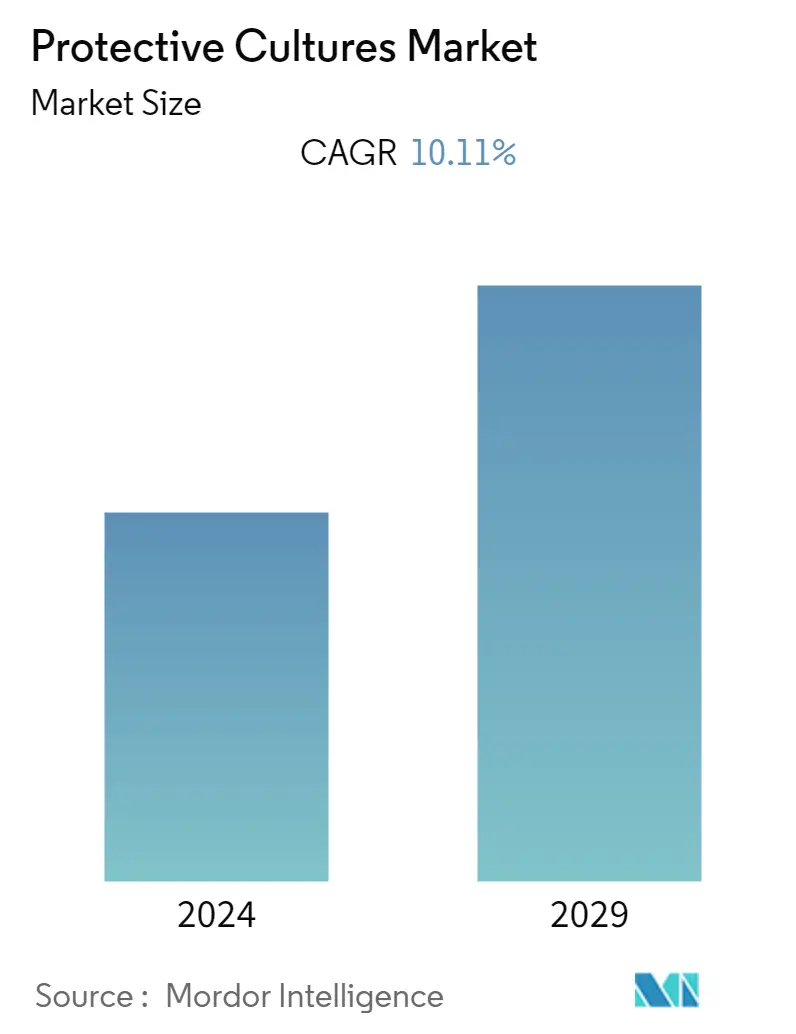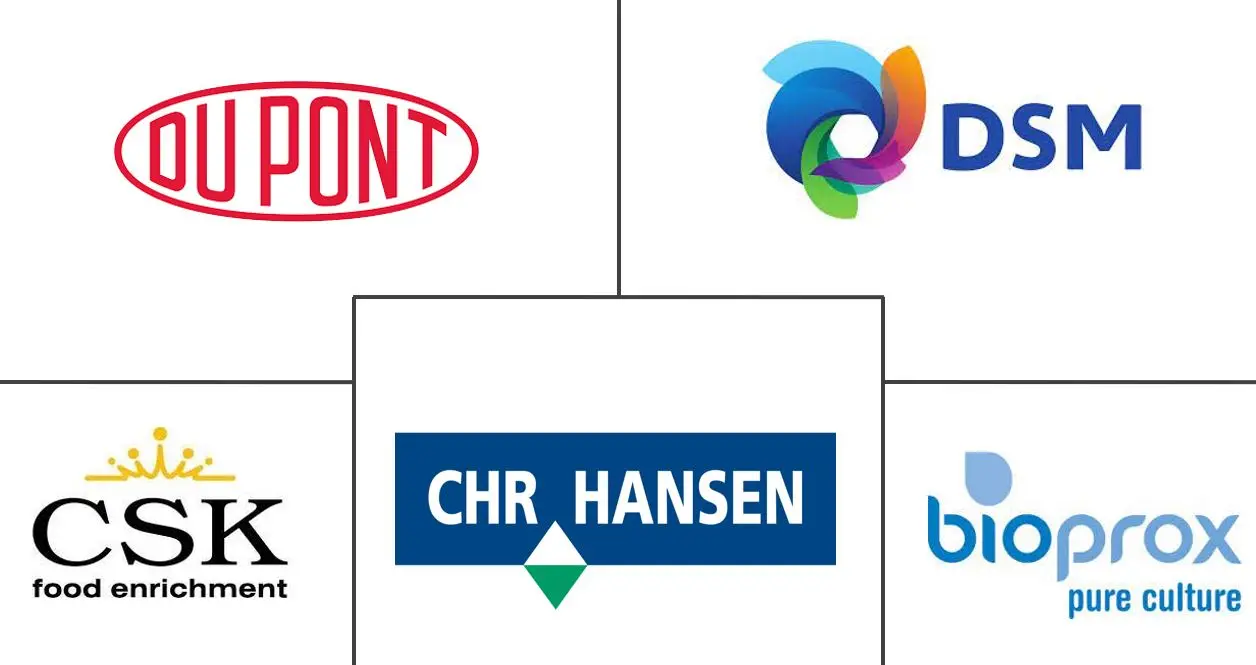Market Size of Protective Cultures Industry

| Study Period | 2019 - 2029 |
| Base Year For Estimation | 2023 |
| CAGR | 10.11 % |
| Fastest Growing Market | Asia Pacific |
| Largest Market | Europe |
| Market Concentration | Low |
Major Players
*Disclaimer: Major Players sorted in no particular order |
Protective Cultures Market Analysis
The Global Protective Cultures Market is projected to grow at a CAGR of 10.11% during the forecast period (2021-2026).
- Protective cultures consist mainly of bacteria, specially selected for their ability to inhibit the growth of pathogenic organisms or microbiological degradation.
- The major use of protective cultures is to maintain fermented foods such as yogurts, cheeses, sour cream, and fermented sausage. Protective cultures have gained popularity as new natural food preservatives due to their use proving to be extremely beneficial for clean label products.
Protective Cultures Industry Segmentation
Global Protective Cultures Market is segmented by product form, microorganism type, application and geography. On the basis of product form, the market is segmented into freeze-dried and frozen. On the basis ofmicroorganism type, the market is segmented intoyeasts, molds, and bacteria. On the basis of application, the market is segmented into dairy products, meat, poultry and seafood products, ready to eat food products, and others. Also, the study provides an analysis of the protective culturesmarket in the emerging and established markets across the globe, including North America, Europe, Asia-Pacific, South America, and Middle East & Africa.
| By Form | |
| Freeze-Dried | |
| Frozen |
| By Microorganism Type | |
| Yeasts | |
| Molds | |
| Bacteria |
| By Application | |
| Dairy Products | |
| Meat, Poultry and Seafood Products | |
| Ready to Eat Food Products | |
| Other Applications |
| By Geography | ||||||||
| ||||||||
| ||||||||
| ||||||||
| ||||||||
|
Protective Cultures Market Size Summary
The protective cultures market is experiencing significant growth, driven by the increasing demand for natural food preservatives and clean label products. These cultures, primarily composed of bacteria, are utilized to inhibit pathogenic organisms and microbiological degradation, making them essential in the production of fermented foods such as yogurts, cheeses, and sour cream. The rising consumer awareness about the benefits of clean label products and the growing consumption of dairy products are key factors propelling the market forward. Companies like Chr Hansen have been at the forefront, launching products that replace artificial preservatives, thereby extending the shelf life of dairy products without compromising quality. The demand for natural preservative-free products is a major driver, with Europe leading the market due to its robust dairy industry, while the Asia Pacific region is expected to witness rapid growth due to increasing awareness and demand in countries like India and China.
The global protective cultures market is characterized by its fragmented nature, with intense competition among strong domestic players and a smaller presence of international companies. Key players such as Chr Hansen, DuPont, and DSM are actively expanding their product offerings to enhance safety standards and extend the shelf life of dairy products. Innovations like DSM's Delvo Guard and DuPont's Lactobacillus Plus highlight the industry's focus on improving product quality and production efficiency. The market is also seeing advancements in bioprotective cultures, as demonstrated by Meat Cracks Technologies GmbH's efforts to combat listeria in meat products. These developments underscore the industry's commitment to meeting regulatory standards and addressing consumer demands for safer, longer-lasting food products.
Protective Cultures Market Size - Table of Contents
-
1. MARKET DYNAMICS
-
1.1 Market Drivers
-
1.2 Market Restraints
-
1.3 Porter's Five Forces Analysis
-
1.3.1 Threat of New Entrants
-
1.3.2 Bargaining Power of Buyers/Consumers
-
1.3.3 Bargaining Power of Suppliers
-
1.3.4 Threat of Substitute Products
-
1.3.5 Intensity of Competitive Rivalry
-
-
-
2. MARKET SEGMENTATION
-
2.1 By Form
-
2.1.1 Freeze-Dried
-
2.1.2 Frozen
-
-
2.2 By Microorganism Type
-
2.2.1 Yeasts
-
2.2.2 Molds
-
2.2.3 Bacteria
-
-
2.3 By Application
-
2.3.1 Dairy Products
-
2.3.2 Meat, Poultry and Seafood Products
-
2.3.3 Ready to Eat Food Products
-
2.3.4 Other Applications
-
-
2.4 By Geography
-
2.4.1 North America
-
2.4.1.1 United States
-
2.4.1.2 Canada
-
2.4.1.3 Mexico
-
2.4.1.4 Rest of North America
-
-
2.4.2 Europe
-
2.4.2.1 United Kingdom
-
2.4.2.2 Germany
-
2.4.2.3 Spain
-
2.4.2.4 France
-
2.4.2.5 Italy
-
2.4.2.6 Rest of Europe
-
-
2.4.3 Asia-Pacific
-
2.4.3.1 China
-
2.4.3.2 Japan
-
2.4.3.3 India
-
2.4.3.4 Australia
-
2.4.3.5 Rest of Asia-Pacific
-
-
2.4.4 South America
-
2.4.4.1 Brazil
-
2.4.4.2 Argentina
-
2.4.4.3 Rest of South America
-
-
2.4.5 Middle East & Africa
-
2.4.5.1 United Arab Emirates
-
2.4.5.2 South Africa
-
2.4.5.3 Rest of Middle East & Africa
-
-
-
Protective Cultures Market Size FAQs
What is the current Protective Cultures Market size?
The Protective Cultures Market is projected to register a CAGR of 10.11% during the forecast period (2024-2029)
Who are the key players in Protective Cultures Market?
Chr. Hansen, Dowdupont, DSM, Bioprox and CSK Food Enrichment B.V. are the major companies operating in the Protective Cultures Market.

